FIELD VETERINARY REPORT FOR AMBOSELI FOR THE MONTH OF SEPTEMBER 2016 Reported by Dr
FIELD VETERINARY REPORT FOR AMBOSELI FOR THE MONTH OF SEPTEMBER 2016
Reported by Dr. Ndambiri Ephantus
Introduction
Amboseli National Park and its environ remain intermittently hot and cool on different days due to the influence of Mt. Kilimanjaro. Wild animals continue to wander in and out of the park in search of forage supplementation. This sometimes doesn’t work well with community around because wild animals intrude into residential and farm areas leading to conflict. It is because of this that the Vet Unit continues to experience human-wildlife conflict based injuries. The month under review has experienced elephant spearing cases. These were attended to promptly thus promoting and quickly restoring animal welfare.
Following are veterinary activities within the conservation area during the month.
CASE # 1 TREATMENT OF AN INJURED ELEPHANT
Date: 4th September 2016
Species: Elephant
Sex: Male
Age: Sub adult
Location: Waerata Kuku Ranch
History
The elephant was spotted and reported by community game scouts as having lameness and remaining static most of the time.
Immobilization, examination and treatment
It was darted with 13mgs Etorphine in 1.5cc dart filled with water for injection. It was in some shrubs which made the approach by vehicle impossible, thus the animal was darted on foot. The dart landed on the right rump prompting the animal to run away with difficulties. It was fully immobilized in seven minutes assuming a sitting position. It was pushed to the left lateral recumbence manually. The right ear was used as blind fold and trunk was kept patent with the aid of a piece of stick at extreme open end.
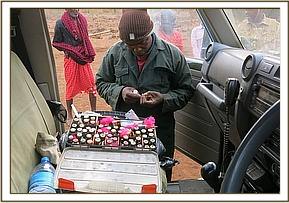

Both fore limbs had traumatic wound injuries within carpal joints. The right one was more severe penetrating from right to left side of limb while the left one had gone through from medial side half way without an exit. Both had missed the joints but sepsis was setting in the tissues. Both limbs were swollen but the right one was more pronounced and this limb was always favored in ambulation. Both wounds were exuding creamy pus and emitting a foul smell. These could have been caused by two different spears with first one going through the right limb followed by the second one on the left limb some time later since the right wound seemed to have initiated healing process much earlier than the left one.


Both wounds were carefully cleaned with Hydrogen Peroxide and Tincture of Iodine allowing removal of dead debris through effervescences. It was followed by infiltration of Tetracycline wound spray into the cleaned cavities followed by generous packing of Green Clay. The elephant was injected with 40mgs Dexamethasone through the ear vein and 30ml Catosal and 15000mgs Amoxicillin intramuscularly at different sites. The dart wound was infiltrated with one Cloxacillin cream tube to avoid abscessiation.
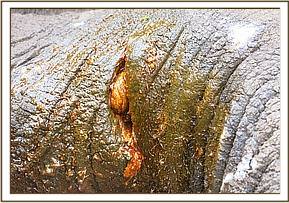

Reversal
The elephant was revived with 36mgs Diprenorphine Hydrochloride into jugular vein. It was completely revived in three minutes and walked away.
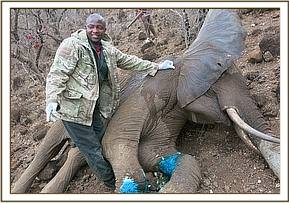

Prognosis
It was given guarded prognosis considering both fore limbs were speared with spreading sepsis involving joint tissues.
CASE # 2 POSTMORTEM OF AN ELEPHANT
Date of death: Unknown
Date of postmortem: 6th September 2016
Species: Elephant
Sex: Male
Age: Adult
Location: Seregei Ranch
History
This elephant had been treated initially on the 12th July 2016 for a spear wound on the right gluteal area and a sole abscess on the right hind limb. Ante mortemly it depicted severe lameness of the left hind limb which was not established as the cause as there was no swelling or crepitation. Review was intended on 28th August 2016 when a visit to the ranch was made only to learn that the last time it was spotted was during initial treatment. A carcass was reported to have been sighted on 6th September 3016 by Lion Guardian rangers who bumped into it while on a trail of a collared lion through the ranch. A postmortem examination was done to establish first whether it is the candidate initially treated and possible cause of death.
General examination
Important observations made were:
-It was in sitting position and two tusks were missing. The carcass had dried up and little foul smell was still present.
-It was established that it had a callus covered fracture of the left olecranon process.
-The dry skin at right gluteal area had a skin tear and the sole of the same limb depicted perforation.
-The green colour on the left lump was present which had been applied by use of Tetracycline wound spray to help in post treatment monitoring.
Postmortem Diagnosis
Possibly succumbed to complications arising after spear injuries which had caused the prognosis to be guarded upon initial treatment.
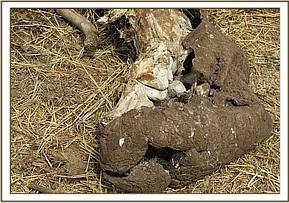

Conclusion
It was established that the carcass belonged to the previously treated candidate who succumbed to injuries thereafter. The fracture on the left hind limb was seen as severe lameness (before death) of the affected limb. The skin break at the right gluteal area and sole perforation on the same limb conformed to antemortem pathology witnessed during treatment. The ivory had been poached possibly by poachers who trailed the animal to its death location or someone who bumped into the carcass by chance. Serengei Ranch is vast and thickly forested. It is patrolled by game scouts who patrol on foot making effective coverage almost impossible. This could have contributed to lack of timely spotting of the carcass there before.
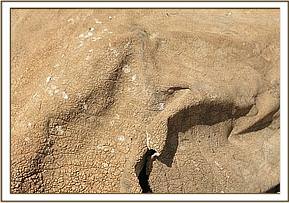

CASE # 3: TREATMENT REVIEW OF AN INJURED ELEPHANT
Date: 7th September 2016
Species: Elephant
Sex: Male
Age: Sub adult
Location:Kimana Sanctuary
History
It was reported by Sanctuary rangers. The elephant had previously been attended to on 8th August 2016 due to an abscess on the lower side of left belly. The swelling had subsided but there were still evidence of creamy discharge hence need for review
Immobilization, examination and treatment
It was darted using 13mgs Etorphine and 1000 I.U Hyalase in 1.5cc dart via vehicle darting. The dart was propelled remotely by use of Dan-inject darting system. He assumed sitting position but was pushed on left recumbence by the help of the strap anchored on the vehicle before flipping him again onto right lateral recumbence to expose the septic injury. Its right ear was used as blind fold to cover the right eye. Trunk was immediately straightened and kept patent by the piece of stick across the nostril opening.
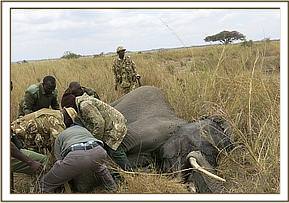

The abscess had shrunk leaving an open wound covered with creamy tenacious pus and its’ muscle cover was fair. It was cleaned with Hydrogen Peroxide and Iodine. There was another wound near linea alba just distal to the abscess wound still with pus. It was cleaned the same way and all were sprayed with Tetracycline wound spray after which they were packed with Green Clay to encourage healing. Systemically it was injected with 30000mgs Tetracycline into muscles at different sites to prevent development of septicemia and 50mgs Dexamethasone was injected intramuscular to ease inflammation.
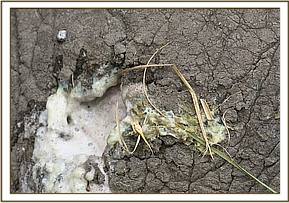

Reversal
It was revived with 40mgs Naltrexone into the superficial ear vein after forty minutes since darting. It was fully up on all four in two minutes energetically and ambulated away strongly.
Prognosis
It is favorable because of good response for treatment.
CASE # 4 POSTMORTEM OF AN ELEPHANT CALF
Date of death: 7th September 2016
Date of postmortem: 8th September 2016
Species: Elephant
Sex: Male
Age: Calf about 2 years old
Location:Lake Jipe-Tsavo West
History
It was reported by OC Lake Jipe KWS base as having succumbed to death on the previous day during late evening hours. It had been spotted having difficulties in breathing with wheezing sounds from the wounded neck ventral area. The rangers retrieved the small tusks for safe custody and onward transmission.
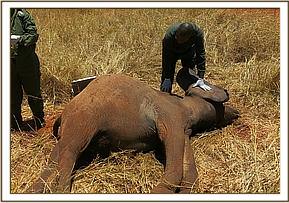
General examination
Examination aged the calf approximately to be of two years. The postmortem was done and these were important observations made:
-It was on right lateral recumbence and observations were done before turning it to left recumbence.
-Dry blackish discharges were noted on the front limbs
-The ventral neck area at the neck base had several penetrating discharging, septic maggot infestedwounds
-At the lumbar area of the spine there was a skin break depicting septic wound. It was pronged and had not penetrated into muscles.
-The carcass was tossed on to left recumbence and conspicuous were several tearing wounds on the left hind and fore limbs laterally midway. The hind went through the cartilage of genu joint interfering with joint integrity and surrounding soft tissue. The fore one though latero-caudally on elbow joint didn’t get into tge joint itself but damaged the soft tissue only. All wounds had foul smell with necrotic tissue present.
-Several shallow scratch-like marks were evident on the left flank and slightly on right.
-At the neck ventrally, the tissues within entire epiglottis area were swollen and edematous. The larynx cartilages had been torn apart making it flaccid. The soft tissue damage had attracted maggot invasion with their larvae. There was little froth at entrance to the trachea.
Postmortem Diagnosis
Cardiorespiratory embarrassment secondary to unsuccessful lion attack.
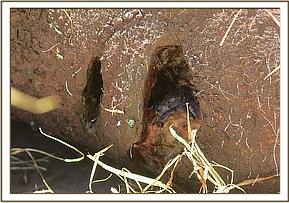

Conclusion
It was ruled that the male calf succumbed to injuries sustained especially at the larynx area. These resulted to insufficient respiration causing cardiorespiratory embarrassment hence death. Ante mortemly this was reported as wheezing sounds at the wounded area as some air escaped through the injury. Predators were presumed to be lions because of the scratches and attempt to strangle and probably the calf fought for his life alone or with assistance from the family members but then mauling sustained at the neck was fatal.
CASE # 5 ELAND TREATMENT
Date: 9th September 2016
Species: Eland
Sex: Female
Age: Adult
Location:Sambu-Isineti area
History
It was spotted and reported by Big Life scouts as being lethargic and lame.
Immobilization, examination and treatment
It was darted using 8mgs Etorphine and 100mgs Azaperone. Dart was delivered by use of dart gun on foot. It was completely immobilized in seven minutes and assumed right lateral recumbence. A blind fold was placed on its head. Dart was retrieved from the dart site and its wound infiltrated with one tube ofCloxacillin cream. Water was intermittently applied after every five minutes on its body to control body temperature.
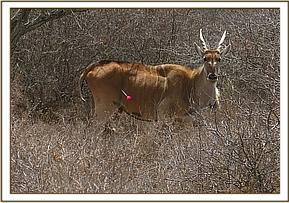

The left hind limb had a swelling medial side at hock joint and was the one causing lameness. It was aspirated using gauge no. 19 needle and yielded flank blood meaning it needed time to ripen before it is drained or lacerated. The tail had a kink at the middle which was due to a transverse wound which was almost severing it completely. This was thought to have been caused by hyena it an attempted attack. The candidate was weak and seemed pregnant which was a burden due to its foot and poor forage cover.
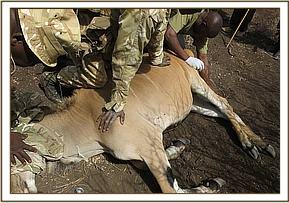

The skin tuft remaining at the tail kink area was severed using scalpel blade and bleeding vessels were ligated. The stump was cleaned using Hydrogen Peroxide and Tincture of Iodine and smeared with Green Clay after Tetracycline wound spray application. It was boosted with 20ml Multivitamin and 4500mgs Amoxicillin into different muscle areas. 8mgs Ivermectin was subcutaneously administered to cater for ecto- and endo- parasites. A review was scheduled after a week so that abscess can be examined for possible draining.
Reversal
It was revived with 24mgs Diprenorphine Hydrochloride into jugular vein. It was left fully aware of its surrounding but sluggish to get up. A guard was left in place and instructed to call after 20 minutes if she failed to walk away but she got up and walked away after seven minutes, even before we had left the location.
Prognosis
It has fair to guarded prognosis because of the poor body state, pregnancy and lack of enough browse.
CASE # 6: ELEPHANT ‘Tim’ COLLARING EXCERISE
Date: 10th September 2016
Species: Elephant
Sex: Male
Age: Adult
Location: Amboseli N.P. Eastern Border
History
The old bull has been identified as perennial crop raider. It is important to note that he bears the longest and heaviest tusks in comparison with his counterparts. This has resulted in man-inflicted injuries to this old bull. He has suffered two spearings in a span of less than two years. This inhumane act could be geared to poaching due to his tusks or as a means of chasing him from farms. This necessitated need to know his whereabouts so that his life can be protected and also to repel him from raiding farms. This was to be achieved by use of GPS Collar which could give his locations especially before every night fall so that PAC Team can follow and remove/relocate him if near farms hence ensuring his security and thus circumvent any human-wildlife conflict. This continues to put him in danger.


The collaring exercise was scheduled for 10th September 2016. This was graced by Director General-KWS amongst KWS fraternity and NGOs. These included the David Sheldrick Wildlife Trust, Wildlife Direct, Safe the Elephant, Amboseli Elephant Trust, Big Life, local community and media houses.
Prior to the planned exercise his health was evaluated on 27th August 2016 when he was spotted in Kimana Sanctuary. He was in the company of other two bulls and who busy browsing healthily and was out of musth. Both previous spear wounds had healed but left little bumps on the left rump and right ear base. He was given a clean bill of health. He was trailed and found near Amboseli N.P. east border with community within the corridor. He was still in the company of two bulls.
Immobilization
He was darted using a vehicle after being directed to an open savannah. Immobilization was achieved by use of 18mgs Etorphine and 2000I.U Hyalase in three centiliter dart. He was scared before and after darting but he was maintained within the open savannah by use of four vehicles until he gained static posture after eight minutes. He then went into incomplete sitting position after four minutes when he was pushed to left recumbence manually. His trunk was straightened and maintained patent by use of a piece of stick at the entrance of the nostrils. His right ear flap was used as blind fold to cover the right eye preventing damage from external stimuli and drying. One tube of Cloxacillin cream was put in the right eye to prevent corneal damage and another one was put in the right medial thigh dart wound to prevent abscess development. He was dowsed with water every five minutes on the ears to control temperature. His initial rectal temperature was 39.5C followed by second reading after five minutes of 38.9C. The third was 38.3C followed by final one of 37.5C just before revival after 20 minutes of the procedure. Initial breathing rate was 8 rhythms every minute dropping to 5 just before revival.
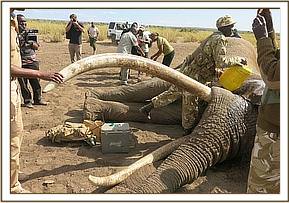

He was covered systemically with 50mgs Dexamethasone injected into gluteal muscles to stabilize the cell membranes because he ran before and after darting.
Sampling
Samples picked included skin tissue from the ears, ticks from various body parts, tail hair and fecal sample.
Collar was donated by Safe the Elephant and Wildlife Direct who also did the fitting under the watch of KWS. It was fitted reasonably loosely to allow ample neck movement permitting for any further growth, if any, and to prevent strangulation.
Examination
The whole body was examined for any injuries or wounds and none were noticed. The larger right bump on the rump was aspirated after palpation but yielded no aspirate. That needle wound was infiltrated with Cloxacillin wound cream to prevent abscessiation.
Reversal
This was done after approximately 35 minutes since darting took place. The vehicle was placed strategically near with straps ready just in case he needed some assistance whilst getting up after revival considering his advanced age. It was revived with 48mgs Diprenorphine into jugular vein concomitantly administered together with 80mgs Naltrexone into muscles. He was completely up in three minutes. He examined the collar using the trunk and shook his head before ambulating away majestically.



























